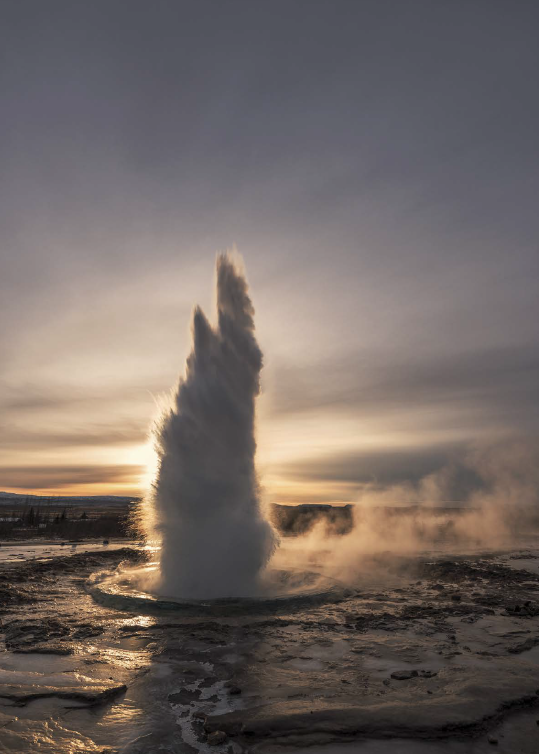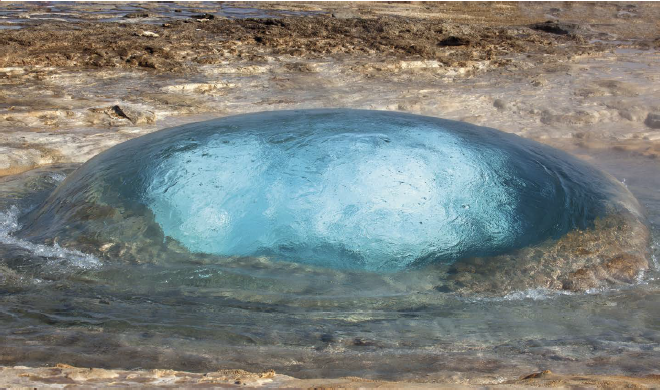This article is an excerpt from Photographing Iceland by Martin Schultz.

GEYSIR AND STROKKUR
Distance: About 50 minutes from Selfoss
Best time of day: Sunrise, sunset, or at night
Best time of year: Summer, fall, or winter
Equipment: No special requirements
Tour type: Self-drive
Parking area coordinates: 64.309415, −20.300758
Location coordinates: 64.312430, −20.300381
A geyser is a hot-water spring that sporadically erupts, sending hot water and steam up into the air. The most famous geyser in the world and the one all others are named after is at Haukadalur in Iceland—a highly active high-temperature geothermal area located close to Laugarvatn. The geyser has been inactive for a while now and, despite attempts by Icelanders to get it to erupt using soft soap, the Stóri Geysir (which means “Great Geyser”) is still slumbering and erupts randomly and rarely.
By contrast, the smaller Strokkur (“Butter Barrel”) geyser is the reason thousands of tourists make the pilgrimage to Haukadalur. Strokkur shoots a water fountain up to 80 feet into the air every 10 minutes or so. Although I have seen it numerous times, I am still amazed by this extraordinary natural force. The Icelanders have often discussed introducing paid entry or parking fees for the Geysir area, but so far, fees have not been implemented.
To get there, take Route 1 to the west out of Selfoss and turn right onto Route 35 just after the gas station at the end of town. Follow the road until you arrive at the parking area and visitor center at Geysir. The site includes a large, well-appointed gift shop and a café that is nice but quite expensive.

Strokkur in golden winter light. (f/10 · 1/60 sec . · ISO 31 · 14mm · Filter: Soft GND16)
If you cross the road from the parking area, you end up directly in the geothermal area that Geysir and Strokkur are part of. There are signs of activity everywhere, with steam and bubbles emerging randomly from the Earth’s crust. In recent years, the authorities have erected increasing numbers of fences and barriers to prevent people from injuring themselves. Plenty of signs warn of the extremely high temperatures that are present just below the surface.
Try just watching Strokkur for a while and make yourself familiar with its rhythm before you attempt to take any photos. Just before an eruption, the water actually starts to appear in increasingly large, pulsing gulps and, before the actual eruption occurs, a bubble forms just above the maw of the geyser and glows blue in the sunlight.
This bubbling is usually the precursor to an eruption, which hurls an enormous fountain of hot water and steam up into the air. Take note of the direction the wind is blowing and make sure you are standing upwind from the geyser if you don’t want to give yourself and your camera a hot shower. Photos of the geyser also look better if you can find an angle that keeps the surrounding buildings out of the frame.

Just before it erupts, Strokkur’s bubbling water glows bright blue. (f/10 · 1/640 sec . · ISO 200 · 105mm)
In general, I prefer not to include people in my landscape photos, but in this case, a couple of observers marveling at the spectacle of an erupting geyser can make an image all the more impressive. Whichever approach you take, visiting the site later in the day ensures that fewer people will be around and makes the experience even more dramatic.
I have captured some great images shooting into the sun on winter mornings with Strokkur in the foreground and the sun illuminating the wonderful landscape with golden, early-morning hues.
TOP TIP
About 15 minutes from Selfoss along Route 35 is a parking area with a sign pointing to Kerið . If you have time, take a quick detour to see this beautifully symmetrical 160foot crater. The entry fee for the site is 350 Icelandic Krona (about $3 .50) at the time of writing.
TOP TIP
There is a pleasant and surprisingly quiet campsite right near Strokkur. I have camped there a couple of times in summer and I thoroughly enjoyed wandering around the area at night.
